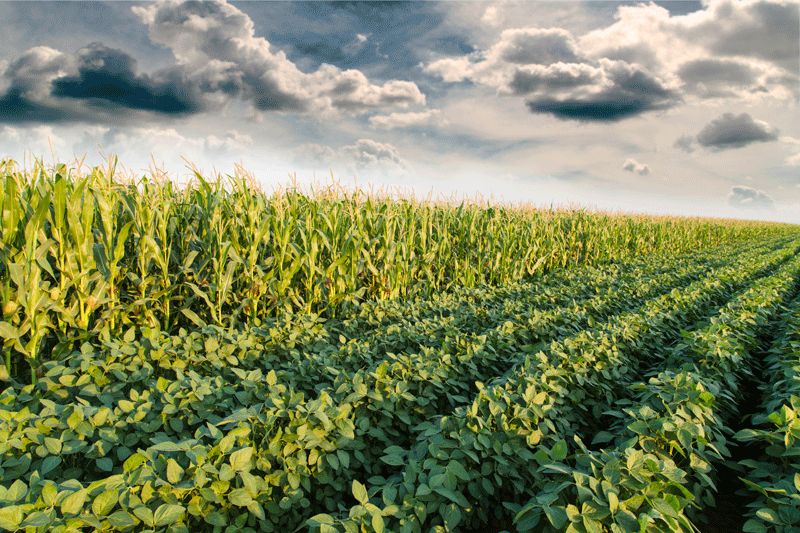Cover crop carryover
TRIALS DETERMINE IMPACT OF RESIDUAL HERBICIDES
THREE YEARS AGO Ontario growers were unsure of how to incorporate cover crops into fields where herbicides were previously applied and related data did not exist. A University of Guelph researcher took this as a challenge and now has completed trials to provide answers.

Dr. Darren Robinson, associate professor in weed management at Guelph’s Ridgetown Campus, has led research efforts to determine the compatibility between a variety of cover crops and commonly used corn and soybean herbicides.
“The initial concern was whether or not cover crops were worth spending money on if herbicides could injure the crop, so we set out a number of studies to find out the tolerance,” says Robinson.
NEW KNOWLEDGE
Robinson’s research began with applying herbicides to corn plots in the spring and planting cover crop trials four months, 12 months, and 24 months after application. Trial areas were also planted without the use of herbicides for comparison. Similar methods were then repeated with soybeans.
The amount of biomass produced, stand reduction, and injury were among Robinson’s key measurements but he says the most unique part about this research is the additional monitoring and analysis of cover crop functions.
Related to the many potential benefits of cover crops, the analysis included measuring how residue impacted each crop’s root dry weight, ability to improve soil aggregate stability, ability to take up nitrogen (N), and ability to reduce the amount of light hitting the surface of the soil.
“There has been some work done at Pennsylvania State University and other institutions in the United States on injury and establishment, but no other study has looked at the impact on the functions of the crop,” says Robinson.
FIELD FINDINGS
The research resulted in cover crops not showing any negative results when planted two years after herbicide application.
“At the four and 12 month mark, we found that there are some combinations of cover crops and herbicides that are just not compatible, such as buckwheat and Pursuit ® and annual ryegrass and Callisto®/ Primextra®,” he explains. “But we confirmed, for the most part, that cover crops are tolerant enough that even if we see 10 to 15 per cent injury, we do not necessarily see a reduction in the function of the crop.”
In soybeans, the research points to the following conclusions related to cover crops:
- Assure ®II: most broadleaves OK to plant; concern for all grasses if less than 120 day waiting interval or at high rates
- Classic®: cereals and ryegrasses OK to plant; concern for small seeded legumes, mustards, sorghum, and buckwheat
- FirstRate™: wheat, triticale, and rye OK to plant; concern for small seeded legumes, mustards, sorghum, and buckwheat
- Pinnacle®SG: wheat, barley, and oats OK to plant; no concerns with 45 day waiting interval
- Pursuit®: wheat, triticale, rye, alfalfa, clover OK to plant; concern for oats, sorghum, mustards, and buckwheat
- Reflex®: cereal grains OK to plant; concern for small seeded legumes, mustards, and sorghum
- Select®: all broadleaves OK to plant; no concerns with 30 day waiting interval
- Sencor® 75 DF: cereal grains and ryegrass OK to plant; slight concern for small seeded legumes and mustards
- Valtera™: all grasses OK to plant; concern for small seeded legumes and mustards
Robinson’s corn trails resulted in fall cover crop recommendations as listed:
- Glyphosate, Liberty®, Frontier® and Eragon® SG: all cover crops OK to plant
- Broadstrike™RC: cereal grains OK to plant; Concern for small seeded legumes, mustards, annual ryegrass, and buckwheat
- Prowl® H2O: cereal grains OK to plant; concern for small seeded legumes and annual ryegrass
FUTURE RESEARCH
While corn and soybean carryover research is complete, Robinson is now working on similar trials with cover crops in winter wheat so he can answer growers’ questions about herbicide combinations in all three crops.
In addition, some new work to determine the impact of interseeding cover crops into corn and soybeans at earlier stages has begun and will continue to be a focus in 2015.
“We want to find out what happens, for example, when we put the cover crop in when corn is at the four to five leaf stage because that would only be one month after herbicide application,” he says.
Detailed carryover residue findings thus far are available through the Ontario Ministry of Agriculture, Food and Rural Affairs as well as in the second edition of the Midwest Cover Crops Field Guide.
This research has been funded by the Agricultural Adaptation Council, Ontario Processing Vegetable Growers, Syngenta Canada Inc., and BASF Canada Inc. •





















